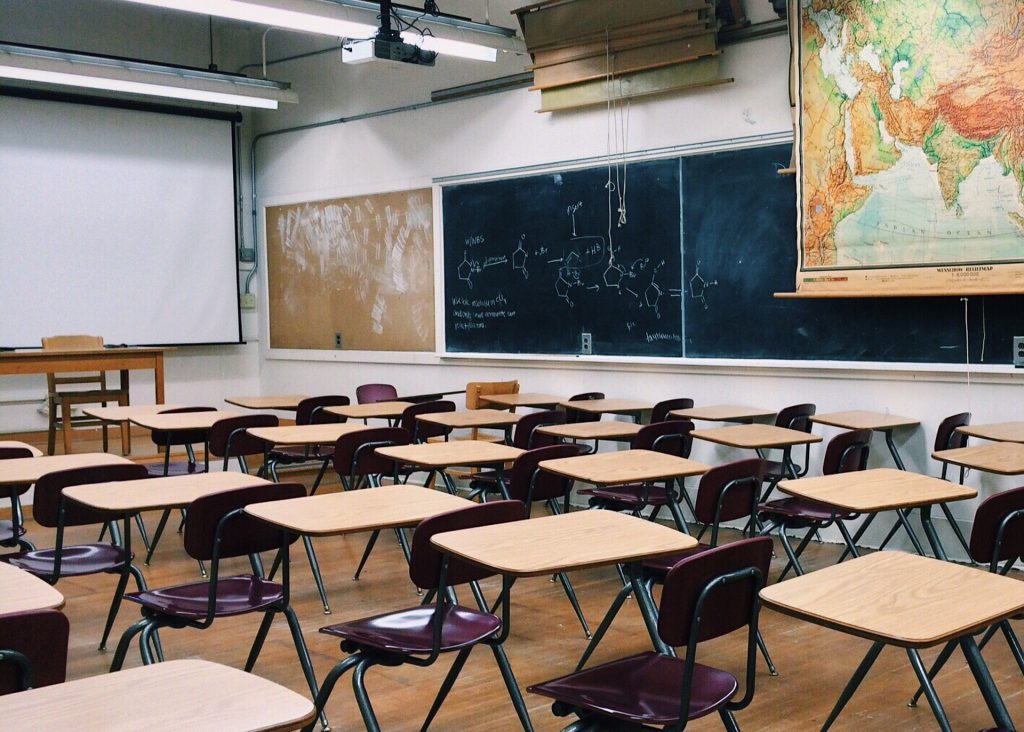Pandemic Causes Shortage of Teachers
Across the state school districts face shortages. Many teachers infected or in quarantine.
Whiplash from continual opening and closing of schools is what the Oak Creek Franklin school district wanted to avoid. But whiplash is what it got.
The Oak Creek Franklin schools were all set to open the school year with in-person instruction as they would normally do. Then in August, just a couple of weeks before the first day of school, the school board reversed direction and closed the buildings in favor of virtual education due to the rising infection rate of COVID-19.
On Sept. 8, the board met again, this time to begin opening the schools in what they would call phase two. The lower grades would socially distance while the middle and high school would use a hybrid model. Upper grades would be split into two groups each attending in-person classes twice a week, going virtual the other three days. This would begin Sept. 28. The infection rate in the community really had not dropped; rather, the health departments in Milwaukee County had determined that schools could open under a more forgiving standard.
Most parents who spoke before the board that night wanted to continue some in-person instruction. They passionately declared that virtual education did not work for their children. “I see my two girls change, and not in a good way. They don’t have the interaction. They are not learning the way they need to learn.”
“The virus is here to stay,” another parent stated. “We have to learn to live with it. We can’t buckle at the first sign of it in our schools.”
Several parents read a litany of statistics. The infection rate was much lower than the quarantine rate. The infection rate in the schools was lower than the infection rate in the general community. Only 19 individuals in the school system were infected. Things weren’t that bad, they said; schools should stay open.
Running out of teachers
When school superintendent Daniel Unertl, had his chance to speak, he had one clear message – we are running out of teachers. He explained that some 50 staff members were out either because they were infected or in quarantine. The district could get substitute teachers for only half of the absent teachers. Teacher aides were filling in for licensed teachers. Central administrators were doing double duty, covering classes for missing teachers in addition to fulfilling their administrative roles. An assistant superintendent was now an acting middle school principal.
In an effort to find enough substitute teachers, the district has hired substitute teachers with full-time contracts and an increase in salary. Other districts are doing the same, but there are simply not enough teachers to meet the substitute demand, especially considering that many substitute teachers are retirees who are less willing to work during the virus pandemic.
“There is a break point,” Unertl said flatly.
At first, school board members seemed to ignore Unertl’s pleas.
Board member Leah Schreiber Johnson said that the school system was not flip-flopping. In order to go back to school, the community had to have lower infection rates for two weeks followed by another two weeks of virtual education before reopening. That was a month to prepare. Closing down was much faster, but the criteria for doing so were set down by the board weeks ago. “We should do the thing we said we were going to do a month ago.”
Finally, board member Sheryl Gernigla spoke directly to the superintendent’s concerns: “Staff is maxed out. I’ve talked to a number of staff. I’ve talked to the administration team. They’re all juggling as much as they can. I just feel we are at the breaking point.”
Board member Darin Grabowski, who showed little interest in virtual education at other board meetings, elaborated on his position. If the district would close down again, and in a couple of weeks the numbers would improve, why should they just go back to a hybrid model? “Why can’t we go all the way, full blown, a regular school day setting? Why not do it… open the doors and let it run and see how it goes?”
Verhalen backed up Grabowski. “We are going to put over 6,000 kids out because we have 15 active student cases and four staff cases? …We are going to create all kinds of turmoil because of 19 cases in the whole school district.”
The board voted to reaffirm criteria which would result in going back to virtual on Monday, Oct. 19 on a vote of 4-3. Before the meeting had ended, Unertl commented on the continual rehashing of opening and closing at board meetings, comparing it to the Bill Murray movie, Groundhog Day.
Struggles around the state
On Oct. 19, the Mount Horeb school district near Madison considered returning kindergarten through second grade students back to in-person instruction after Dane County Health revised its criteria for an acceptable level of infections for in-person education.
No statewide criteria for opening or closing schools is being followed. Health departments in each community are establishing their own standards. School districts, in turn, consider health departments’ guidelines only as a suggestion.
Mount Horeb parents spoke on both sides concerning reopening schools.
School Board member Kimberly Sailor expressed the growing understanding of how the virus is affecting teachers here and in other districts. “Two weeks in and two weeks out. Either from positive tests or they have simply drained all the staff resources, they don’t have enough manpower to keep these buildings open.”
Mount Horeb voted to allow K-2 students to return to in-person schooling. Board members Leah Lipska and Kimberly Sailor voted against stating safety concerns. Shortly thereafter, a recall petition was started against the two of them.
A recall petition was also started in Middleton Cross Plains against board members who voted against reopening. A parent backlash may be driving some school boards to maintain or implement in-person instruction. In many districts, parents who want to have their kids in school seem to dominate board public comment sessions. Parents who prefer virtual instruction usually have that virtual option no matter what the rest of the district does.
Yet other school districts have been closing for lack of teachers. In late September, Kenosha schools closed for in-person instruction for several days after a third of teachers called in sick. The Elmbrook school district, just west of Milwaukee, announced that Brookfield East High School would close due to a teacher shortage. This was on Oct. 19, the same day Mount Horeb decided to open its schools for some students.
Reedsburg began the school year using a hybrid model. Then on Oct. 4, it changed its elementary students to a four-day, in-person schedule. On October 20, the board announced it was returning to hybrid. The district has over 2,800 students, but 342 students and 32 staff members are currently under quarantine.
Dan Rossmiller, director of government relations for the Wisconsin Association of Boards of Educations (WASB), explains why school districts appear to be running in all different directions during the pandemic. He cites several reasons for inconsistent policies. Rating criteria for changing between the in-person and virtual instruction varies by district, for one thing. Even at the federal level, he notes, “just today the CDC changed its definition of what close contact is … Those criteria are inconsistent across the state.”
“The other reason why schools are closing is simply related to personnel,” says Rossmlller. “If you have had teachers in close contact with individuals who have tested positive, then they have to go into quarantine for 14 days. If the school does not have enough teachers or enough substitutes to operate in person, then they have to go virtual while the teachers remain in quarantine.”
“There is such a shortage of substitute teachers that many districts are hiring substitutes to permanent contracts, providing them with benefits,” Rossmlller adds. “Others are jacking up the daily rates.”
Oconto Falls
Oconto Falls has been feeling the same pressures as other small towns and rural districts across Wisconsin. Situated 30 miles northwest of Green Bay, Oconto County has experienced one of the highest infection rates in the state.
“We did go virtual because we had so many staff members out,” says Valarie Nickels, a middle school teacher in the district, “We didn’t have enough bus drivers to pick up the kids, we didn’t have enough teachers in the classroom. Some teachers could teach remotely from their houses, but they needed the support staff to go into those classrooms as adult coverage. Teachers were out because they were in close contact or quarantined because of a family member.”
Oconto Fall will remain virtual until Nov. 2. Then the board will re-evaluate the decision to reopen.
Like a lot of other districts, Oconto Falls has tried to keep education as normal as possible. However, it does not matter whether a district is liberal or conservative; rich or poor; urban, rural, small town or suburban; whether parents are demanding in-person education or not; once a district runs out of classroom teachers, it is going virtual.
Reprinted with permission of Wisconsin Examiner.





















